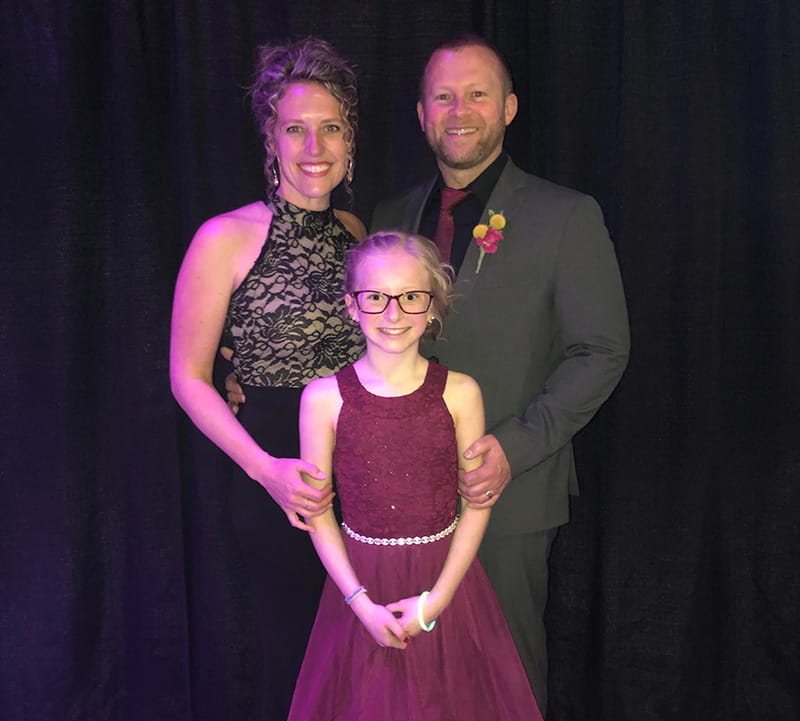At 12, she's on her third pacemaker
By Diane Daniel, American Heart Association News

Jennifer and Patrick Tallquist were resting peacefully with their 1-day-old daughter Abrielle when a nurse entered their hospital room to give the newborn a test.
The nurse hooked up 6-pound "Abbi" to a monitor that checked her heartbeat. Minutes later, the lab called the nurse.
"You can see that already?" she said into the phone.
She then scooped up Abbi and left the room, offering no explanation.
A few hours later, Jennifer and Patrick were reunited with Abbi and received the first details of her problems – she had an arrhythmia, or irregular heartbeat. While doctors at Mercy Health, Muskegon were able to diagnose the problem, they sent her for specialized attention at Helen DeVos Children's Hospital in Grand Rapids, Michigan, an hour away.
After two days of tests, Jennifer and Patrick learned Abbi's abnormal heartbeat was caused by long QT syndrome, where the lower chambers of the heart take too long to contract and release.
"She's going to need a pacemaker," the doctor said.
"Like for old people?" Jennifer asked.
The pacemaker would regulate her heartbeat. But she was so small that accommodations needed to be made; it was placed in her abdomen instead of near her collarbone. The doctors also had to wait two weeks for her to gain enough weight to do the surgery.
"When we got to bring her home, it was so scary," Jennifer said. "For the first two months, she was extra fragile."
As she got older, Abbi was as active as any toddler. A monitor linked to the pacemaker sent readings to the hospital, which continually showed no problems. That is until she was 4. The battery was depleted, meaning she'd need a new pacemaker.
By now, Abbi had a new pediatric electrophysiologist, Dr. David Bradley, director of heart rhythm care at the University of Michigan's C.S. Mott Children's Hospital in Ann Arbor, a three-hour drive from their home.
"He is the most wonderful blessing we could have asked for," Jennifer said.
This time, Abbi received in her abdomen a pacemaker with an implantable defibrillator that could shock her heart into a normal rhythm if needed.
One day when Abbi was 7, the pacemaker's alarm sounded.
"They told us it would sound like a British siren," Jennifer said. "And it did."
The shock wire had broken, and new wiring was needed. Bradley took the opportunity to replace the equipment as well. The new pacemaker and defibrillator, Abbi's third and the one she currently uses, was a little smaller thanks to technical advances. Because of her slight stature, it again went into her abdomen.
Bradley said Abbi could lead a normal life. Among her few restrictions were competitive sports.

All was going well until one evening when Abbi was 8. Jennifer was cooking and Abbi was at a nearby table doing her homework. She walked over to her mother, and passed out, hitting the floor. She regained consciousness almost immediately. She said she felt fine, like she'd dreamed the fall.
After she fainted again a few minutes later, Patrick quickly sent the pacemaker data to the hospital. Just minutes later, Bradley called.
Abbi's heart rate was spiking to over 220 beats per minute. This would normally trigger the pacemaker to send a shock, but her heart was recovering on its own just before tripping the signal.
"We headed to Ann Arbor that night," Jennifer said. "I was crying and praying the whole time."
Abbi had what's called an electrical or arrhythmic storm, with sustained cardiac episodes. She passed out six times within 12 hours. The problem was solved by raising her resting heart rate from 70 beats per minute to 110. (It's now set at 85.)
As the pandemic swept across the country, the Tallquists were vigilant about limiting Abbi's possible exposure. In mid-May, after discussing everything repeatedly with Bradley, they began expanding their circle. She's since begun swimming and performing in an outdoor play (with physical distancing). Abbi also has enjoyed training the family's new puppy, Liberty.
"I can't do much sports, but I did find out that next year I can play volleyball at school because it's not a ton of running," she said.
Now 12, Abbi is interested in becoming an elementary school teacher or a pediatrician. She also started sharing her story. Last year, she was a "heart hero" at the American Heart Association Heart Ball in Grand Rapids.

Another chapter of her story remains to be written: She's likely to get a new pacemaker within a year. The good news is that she's grown enough that the next device should be placed in the typical spot.
"I can finally have that flat tummy I've wanted," she said, laughing.
Stories From the Heart chronicles the inspiring journeys of heart disease and stroke survivors, caregivers and advocates.
If you have questions or comments about this story, please email [email protected].





